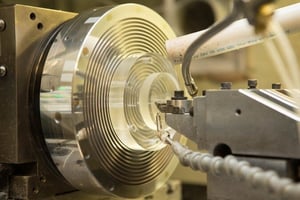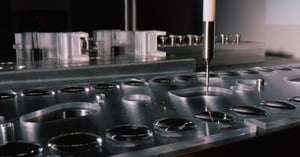
Single Point Diamond Turning
Apollo's Single-Point Diamond Turning (SPDT) lathes produce superior optical surface finishes and consistent performance in plastic and metals. The SPDT process is used to fabricate optical components and to machine the optical surface on the inserts used in the molding process.
The SPDT process can fabricate small quantities of custom optical prototypes prior to production molding the optics.
Apollo Optical Systems currently has three Single Point Diamond Turning lathes: One Innolite IL300 and two Precitech Nanoform 200 lathes (for manufacturing asymmetrical components).
- Apollo has custom proprietary diamond tools with radii as small as 1.5 micron.
- Apollo produces optical components ranging from 1 mm to 300 mm in diameter.
- Apollo has achieved better than the typical finishes in all materials. For example Apollo has achieved a 13 Å RMS surface finish in Nickel for a specific customer and 31 Å RMS surface finish in Polystyrene for another customer.
- Apollo typically achieves 60-80 Å RMS surface finish and < ½ wave peak-to-valley surface figure in most polymers. Apollo Optical typically achieves 30-50 Å RMS surface finish and < ¼ wave peak-to-valley surface figure in metals.
What can we do for you?
Apollo routinely diamond turns optics from the following materials; plastic (Acrylic, Styrene, Zeonex, Zeonor, Ultem), Nickel, Brass, Copper, Aluminum and many other materials.
Apollo Single Point Diamond Turning is capable of machining the following types of optical surfaces:
- Conics
- Diffractive
- Fresnel
- Toroidal
- Aspheric
- Spheres
- Plano
Single Point Diamond Turning – Quality from beginning to end
From our initial discussions with our customers, through delivery, quality is always our main concern. Our Single Point Diamond Turning center is supported by the latest Apollo metrology. Our knowledge and extensive experience of optical design and metrology allows us to perform complete characterization of all our SPDT optical components and molding inserts.
Apollo has an extensive in-house design and testing infrastructure to support its Single Point Diamond Turning services. Support capabilities include:
Optical Engineering
- Surface Modeling
- Lens Design
- Apollo uses proprietary software in combination with commercial mechanical design software (DIFFSYS®) to create the SPDT tool path.
Optical Testing
- Interferometers to measure surface figure
- Contact Profilometer to measure surface figure and diffractive or Fresnel features
- White Light Interferometer to measure surface roughness and diffractive or Fresnel features
Our expertise in SPDT and molding has placed Apollo at the forefront of the optics industry.
SCHEDULE A MEETING WITH AN EXPERT
FAQ
Find out more about single point diamond turning (SPDT) and how it affects optical components and systems.
What Are Some Capabilities when Using Diamond Turning for Optics Production?
- Producing parts with very high precision, often down to a few microns or less, for precise geometries and surface finishes
- Creating versatile optical components, including lenses, prisms, and mirrors
- Accommodating a range of materials, including metals, plastics, and ceramics
- Producing freeform micro-optics for specific applications
- Manufacturing high-precision components in a cost-effective manner
What Materials Can Be Used in Single Point Diamond Turning?
Single point diamond turning is a versatile manufacturing option that can be used with:
- Metals like copper, aluminum, nickel, and brass
- Optical plastics like polymethyl methacrylate (PMMA), cyclic olefin polymer/copolymer (COP/COC), polystyrene (PS), and optical polyester (OKP4)
- Infrared materials like silicon and chalcogenide glass.
How Precise Can Diamond Turned Optics Be and What Tolerances Can Be Achieved?
Depending on the equipment and systems’ precision, single point diamond turning can achieve machining accuracy of 1 nm or less and material removal rate of more than 10−4 mm3/s.
What Types of Optical Components Can Be Produced Using Diamond Turning?
Diamond turning is an ideal manufacturing method for a range of optics applications, including:
- Imaging: Optical components created with diamond turning are used in imaging systems like microscopes, endoscopes, cameras, and telescopes. These components focus light and reduce optical aberrations for small devices.
- Telecommunications: Diamond-turned components are used in fiber optics and other telecommunications systems to increase frequency and reduce loss.
- Sensors: Optical components are used in sensors for numerous applications, including medical diagnostics, industrial process control, and environmental monitoring.
How Does the Cost of Diamond Turning Compare to Other Manufacturing Methods for Optics?
Depending on the project’s specifications, diamond turning can be a cost-effective and affordable option over other optical manufacturing methods. Prototyping typically involves a higher upfront cost with lower per-unit costs.
One advantage of using SPDT with polymer optics is that many optical polymers can be directly diamond turned. This means that prototype optics can be produced (via SPDT) in the same material that will be used in mass production (via injection molding).
What Are Some of the Challenges Associated with Diamond Turning, and How Are They Addressed?
Single point diamond turning leaves tiny tool marks on finished surfaces, which can degrade the optical performance. Typically, these tool marks are inconsequential if the optical elements are big enough, so this consideration should be addressed in the design phase. In addition, smoothing techniques like bonnet polishing, magnetorheological finishing (MRF), and ion beam figuring (IBF) can remove residual marks.
Despite the versatility of single point diamond turning, there are also material restrictions. It can accommodate a range of plastics, metals, and infrared crystals, but not glass. One solution is to machine the mold with a compatible material, then use a glass press molding machine to fabricate it.
What Are the Most Common Applications for Diamond Turned Optics?
Single point diamond turning is used for applications that require complex optical shapes and geometries, including:
- Illumination
- Imaging
- Security domes
- Projectors
- Mirrors
- Spectrometers
- Low-voltage, high-efficiency lighting
- TIR and LED
- Collimating or diffusing light
- Infrared and night vision
- Blood analysis
- Head-up displays
- Probes
- Fingerprint scanners
- Weapons sights
- Barcode scanners
These components have many uses in automotive, aerospace, medical, security, consumer products, and military and defense industries.
What Should Be Considered When Selecting a Manufacturer for Diamond Turned Optics?
Single point diamond turning is selected as a manufacturing method for its unique advantages in precision, performance, and cost-effectiveness. The human operator is just as important as the process itself, so choosing the best manufacturer for your optics project is essential.
Some of the things to consider include:
- The manufacturer’s technology and equipment with high precision and tight tolerance
- The capacity to machine custom prototypes and production units
- Finishing capabilities
- Materials capabilities
- In-house design capabilities
- Sophisticated metrology and quality control
- Experience and expertise to handle each step of the process for a favorable finished product
